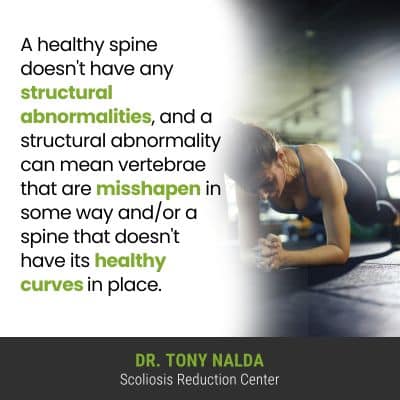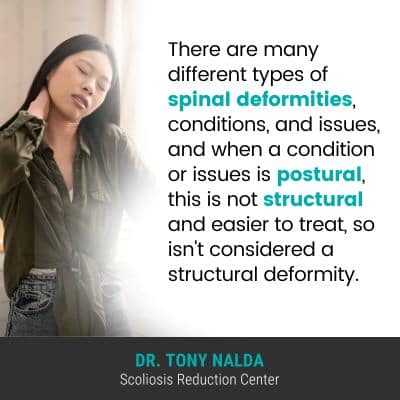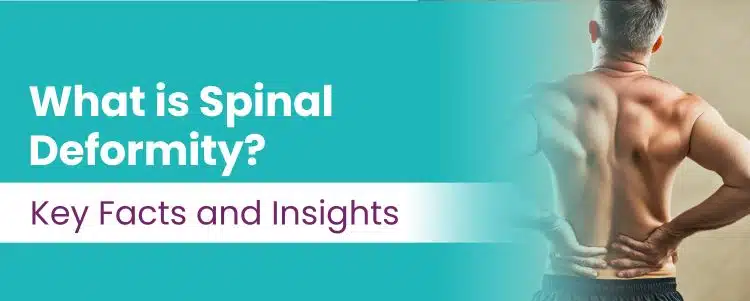Scoliosis is the leading spinal deformity among school-aged children, and kyphosis and lordosis are additional spinal conditions that involve structural abnormalities and the development of unnatural and unhealthy spinal curves.
Spinal deformities involve structural abnormalities within the spine itself. Common spinal deformities include scoliosis, kyphosis, and lordosis, and these conditions involve a loss of the spine’s healthy curves that disrupt its biomechanics.
When the spine is deformed in some way, it is misshapen, misaligned, and/or doesn’t have its natural curves in place.
Healthy Spines
Healthy spines have their natural and healthy curves in place, and their vertebrae are aligned: stacked on top of one another in a straight and neutral alignment.
A healthy spine will appear straight when viewed from the front and/or back and will have a soft ‘S’ shape when viewed from the sides, and the spine’s healthy curves make the spine stronger, more flexible, and better able to absorb and distribute mechanical stress during movement.

A healthy spine doesn’t have any structural abnormalities, and a structural abnormality can mean vertebrae that are misshapen in some way and/or a spine that doesn’t have its healthy curves in place.
A spinal deformity means the spine’s biomechanics are disputed and its function will be impacted, so let’s talk about some different spinal conditions that are considered spinal deformities.
Scoliosis
According to the Scoliosis Research Society, there are currently close to seven million people living with scoliosis in the United States alone.
Scoliosis is the most prevalent spinal deformity among school-aged children, and this warrants awareness because while there are no treatment guarantees, treatment success is more likely with early detection and intervention.
Scoliosis is a structural deformity that involves the development of an unnatural spinal curve; not only does the spine bend unnaturally to the side, it also twists, making scoliosis a 3-dimensional condition.
Scoliosis is a progression condition, meaning its nature is to get worse over time, and this means the vertebrae that are unnaturally tilted will become more tilted, making the curve larger, introducing more and more uneven forces to the spine, its surroundings, and the entire body.
As progression occurs, the condition is getting more severe, and the condition’s effects become more overt and noticeable, and a sagittal imbalance will become more noticeable, causing disruptions to balance, coordination, and gait.
In children, the most noticeable effect of scoliosis involves postural changes, and in adults, it’s pain; scoliosis becomes a compressive condition once skeletal maturity has been reached, and it’s compression of the spine and its surrounding muscles and nerves that causes the majority of condition-related pain.
There are also different types of scoliosis a person can develop from idiopathic scoliosis to degenerative scoliosis, congenital scoliosis, and neuromuscular scoliossis caused by a larger neuromuscular condition such as cerebral palsy, spina bifida, and cerebral palsy.
Scoliosis ranges widely in severity from mild to moderate and severe to very severe scoliosis, and as a structural deformity, that means no change in position will change the unnatural spinal curve, and that’s the difference between a structural spinal condition and a nonstructural condition.
A structural spinal deformity can only be impacted on a structural level to be treated effectively because the condition’s underlying nature is structural.
In addition to scoliosis, there are spinal conditions that cause natural spinal curves to become excessive and unhealthy.
Kyphosis
The spine has three main sections, and each has its own characteristic curvature type.
The thoracic spine is the largest spinal section and is the only section attached to the rib cage, and the thoracic spine features what’s known as kyphosis, meaning a spinal curve that bends backwards, away from the body’s center.
A person’s level of kyphosis can vary from person to person, but if the level of kyphosis becomes excessive, this is beyond a healthy range and becomes problematic.
If the thoracic spine develops structural kyphosis, the level of kyphosis is problematic and will disrupt the function of the spine.
Kyphosis refers both to healthy and unhealthy levels of thoracic kyphosis, and a healthy level of kyphosis would fall within a range of 20 and 40 degrees, and hyper kyphosis is commonly diagnosed at 50+ degrees.
Another name for excessive kyphosis is roundback because of the excessively rounded forward upper back and shoulders that develop as the spine bends excessively backwards.
Symptoms of kyphosis can include:
- Back pain
- Postural changes
- Difficulty standing for long periods of time
- Fatigue
- Numbness and tingling sensations due to nerve compression
- Bladder and/or bowel issues
So a spinal deformity that involves a healthy curve becoming excessive can also be problematic.
Lordosis
Lordosis refers to the cervical spine and the lumbar spine’s curvature type that bends inwards, towards the body’s center, and if a person’s level of lordosis becomes excessive, this most often involves the lumbar spine and causes a swayback appearance.
A healthy range of cervical lordosis falls between 20 and 40 degrees, while a healthy range of lumbar lordosis falls within a range of between 40 and 60 degrees.
Symptoms of hyperlodosis can include:
- Back and muscle pain
- A swayback appearance where the abdomen and buttocks protrude excessively
- Mobility issues
- Sciatic nerve pain
- An inability to lie flat on the floor and have the spine in contact with the floor because of the excessive lordotic curvature
A significant effect of many spinal conditions develops alongside compression, uneven pressure introduced to the spine and its surroundings that can cause a number of symptoms.
For example, in lumbar lordosis, as the sciatic nerve starts in the lumbar spine, it can expose the sciatic nerve to compression, and this can cause it to become compressed, irritated, inflamed, and/or impinged.
Hyperkyphosis is also known as swayback because of how it changes posture and appearance.
Can Spinal Deformities Be Treated?
There are many different types of spinal deformities, conditions, and issues, and when a condition or issues is postural, this is not structural and easier to treat, so isn’t considered a structural deformity.

An abnormal curvature of the spine can be postural, meaning it’s caused by chronic poor posture, and in these cases, a change in position and/or efforts to correct posture can adjust the unnatural curve or issue, but when spinal alignment is disrupted on a structural level, there is a structural abnormality within the spine itself that no change in position can remedy or improve.
Spine deformities can be addressed in a number of ways, and there are a number of different treatment choices and approaches for patients to choose between.
While there is often spinal surgery to consider, there are many instances where spinal alignment, spinal balance, strength, and flexibility can help patients avoid the risks of surgical treatments and spinal deformity surgery.
With scoliosis, for example, here at the Scoliosis Reduction Center® , I offer a nonsurgical treatment alternative with proven results; many cases of scoliosis don’t require surgical treatments, particularly when early detection and intervention are accomplished.
Some spinal deformities, particularly those are that are severe, atypical, or congenital can be structurally complex enough to warrant a surgical response, but when diagnosed early and treated proactively, there are fewer limits to what can be achieved without needing to face the risks of surgery.
Condition-specific chiropractic care, physical therapy, corrective bracing, and rehabilitation can help address scoliosis, lordosis, and kyphosis.
Spinal deformities can cause a wide range of symptoms felt throughout the body due to spinal cord compression, and adult spinal deformities are painful because while the spine is still growing, the lengthening motion can counteract the compressive force of the unnatural spinal deformities.
Conclusion
When it comes to structural issues with the vertebral column, this means the bones of the spine itself; the spine consists of a bony vertebral column, and when then spine develops a deformity due to injury, trauma, conditions, and/or spinal issues, diagnostic tests are necessary to determine the underlying cause of the deformity.
Spinal deformities can be painful, and pain relief is a focus of treatment, but it’s important to understand that addressing pain caused by deformities and/or pinched nerves isn’t the same as addressing its underlying structural nature.
Conservative treatment can involve integrating multiple different treatment disciplines, and whether it’s for scoliosis, kyphosis, lordosis, flat back syndrome, many progressive conditions are triggered by spinal growth, which is why childhood spinal conditions should always be taken seriously.
A mild and/or moderate deformity, if caught early, in many cases, can be corrected with a combination of chiropractic adjustments, physical therapy so spines can be optimally supported and stabilized, corrective bracing to help push the spine into a straighter alignment, and rehabilitation to further heal and stabilize the spine.




